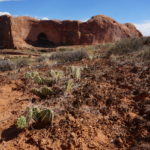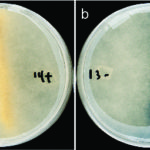Unlike white rots, brown rots break down only the cellulose and hemicellulose, leaving the lignin behind. The brown rot Serpula lacrymans is typically found in spruce and other conifers in boreal forests. As these trees were harvested for constructing buildings, the dry rot fungus migrated indoors and across borders, adapting to thrive in manmade environments. Reported January 5, 2018 in The ISME Journal, a comparative genomics analysis by a team led by University of Oslo scientists and including JGI researchers lends insights on how the fungus has responded to manmade changes in its ecological habitat, adapting to thrive in built environments. Learn more on the JGI website.
Microbial Metabolism in Real World Native Biocrusts
Biological soil crusts, or biocrusts, contain communities of microorganisms—including fungi, bacteria, and archaea—that dwell together within the uppermost millimeters of soil in arid lands. These microbes can exist for extended periods in a desiccated, dormant state, becoming metabolically active when it rains. Understanding how biocrust microbial communities adapt to their harsh environments could help shed light on the roles of soil microbes in the global carbon cycle. Berkeley Lab scientists led by Trent Northen’s group in Environmental Genomics and Systems Biology (EGSB) found that specific compounds are transformed by and strongly associated with specific bacteria in native biological soil crust. The researchers reported their findings in a paper published January 2 in Nature Communications.
JGI Uses Brachypodium to Gauge Plant Pan-Genome Size
A pan-genome, the non-redundant union of all the sets of genes found in individuals of a species, is a valuable resource for unlocking natural diversity. However, the computational resources required to produce a large number of high quality genome assemblies has been a limiting factor in creating plant pan-genomes. In Nature Communications, an international team led by JGI researchers gauged the size of a plant pan-genome using the JGI Plant Flagship Genome of Brachypodium distachyon, a wild grass widely used as a model for grain and biomass crops. Read more on the JGI website.
JGI Helps Develop Database for Plant Microbiome Studies
To help improve crop breeding strategies and overcome challenges such as making plants more tolerant of marginal lands, and stresses such as drought and low nutrient availability, researchers are focusing on understanding and promoting beneficial plant-microbe relationships. In Nature Genetics, a team led by JGI and University of North Carolina at Chapel Hill researchers assembled a catalog of plant and microbial genomes to identify and characterize candidate genes that aid bacteria in adapting to plant environments. “Here we used a massive genomic and computational effort to address the fundamental and important question: ‘How does the plant microbiome interact with the plant?’” said study co-first author and JGI research scientist Asaf Levy, a research scientist at the JGI. Read more on the JGI website.
JGI Sheds Light on Fungal-Bacterial Mutualism
In heritable mutualisms, hosts pass on beneficial symbionts between generations. The origin of this relationship though, is often antagonistic and the parasite first needs to secure its own transmission before working with the host. Using the mutualistic relationship between the plant pathogenic fungus Rhizopus microsporus (Rm) and Burkholderia endobacteria, JGI and Cornell University researchers reported on how the antagonistic-to-mutualistic transition occurs in Nature Communications. The team found that the oil-producing fungus is highly dependent on the Burkholderia endobacteria to proliferate both sexually and asexually. This dependence is consistent with the addiction model of mutualism evolution. Read more on the JGI website.
- « Previous Page
- 1
- …
- 32
- 33
- 34
- 35
- 36
- …
- 46
- Next Page »
Was this page useful?








